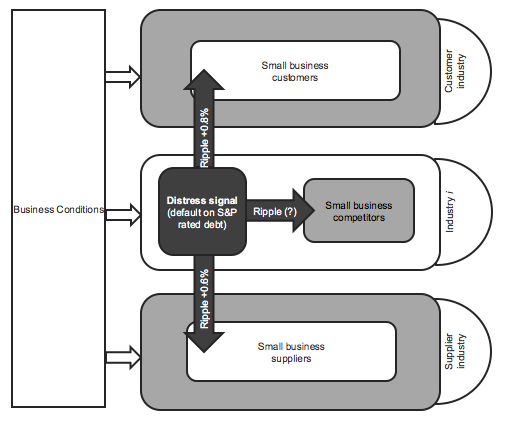With an economic slump in Europe and a fragile recovery in the US, banks are preparing for an increasing number of firms to fall behind on their loan payments. To model and forecast when those failures cluster in time is a challenge in risk management. It is an even greater challenge for any bank that finances small firms. Such a bank must rely on soft information rather than hard information and does not observe its borrower’s financial statements, bond prices, and production partners (counterparties).
As shown by current research, failures can cluster in time as a result of counterparty risk. In particular, a supplier or a creditor to a distressed firm is likely to experience distress herself in the near future. Among others, Hertzel et al. (2008) show that any bankruptcy is followed by a negative stock price reaction among creditors. Similarly, Jorion and Zhang (2007) argue that worsening credit quality of a borrower precedes future distress of her creditor. Based on this finding, Jorion and Zhang (2007) follow an existing methodology by Vasicek (1991) and devise an application of counterparty risk to portfolio risk management. The application requires information on probability of default and a matrix defining customer-supplier relationships between firms in a loan portfolio. Once a default is observed a firm linked to the default has its probability of default increased by 0.25%. In general, any bank should be able to compute the individual probability of default for each borrower, but obtaining a matrix of customer-supplier relationships is more cumbersome.
The matrix of customer-supplier relationships can potentially be obtained from (1) SFAS No 131 interim segment reports, (2) surveying borrowers on their customers and suppliers, (3) approximating the customer-supplier relationships by publicly available data. Regarding option (1), banks can access interim segment reports to create a list of the largest customers of the borrower in question. This list can also be extracted from Compustat or Bloomberg. This option does not exist for small firms as they are not subject to the SFAS No 131 reporting. Regarding option (2), with every new loan the bank can potentially collect data on customer-supplier relationships. However, the collection of new data is costly for the bank and for small firms.
Option (3) is to approximate the customer-supplier relationships using publicly available data. Using public data makes this option cost-efficient, but do public data offer a sound alternative in modelling counterparty risk for small firms?
Input-Output tables can approximate individual firm counterparty exposures
In new research (see Bams et al. 2015) at the Maastricht University, WHU-Otto Beisheim School of Management and the University of Luxembourg, we show that industry production linkages constitute a viable alternative to model counterparty risk. This study shows that the default rate among small firms are significantly higher in the presence of a default on S&P rated debt in an industry that buys products in the same industry.
In a recent paper (Bams et al. 2015), we propose replacing the matrix of customer-supplier relationships with public information at the industry level. They approximate the matrix of customer-supplier relationships by the Input-Output matrix, which identifies customer and supplier industries. By doing so, the researchers use the fact that a large share of commodities is an intermediate input to the production process of another commodity. So the production process is a natural mechanism that organises firms’ behaviour across industries.
For example, consider a subset of industries in Figure 1. Now, imagine the middle industry uses an intermediate output of the bottom industry in its own production, which is then delivered to the top industry. In this case, firms from those industries enter a supplier-customer relationship. Now suppose there is a distress in the middle industry. The existence of the production process linkage indicates that at least some firms can be directly exposed to the distress of their production partners. Following that, they can face financial distress themselves.
Figure 1. Ripple of risk to customer, supplier and same industry
Note: Industry i awaits intermediate inputs from supplier industry and owes to complete products for the customer industry but it experiences a distress signal. The distress signal is said to be a default on debt reported by S&P. Following the distress signal, the failure rate of small firms in customer industry increases by 0.8% and in supplier industry by 0.6%.
The question is which public information can serve as a robust distress signal. We propose one in our paper. We identify any failures reported by S&P to be easy, publicly available distress signals. Our recommendation is that, following a failure on debt reported by S&P, banks that hold loans to small firms that operate in industries supplying to the distressed industry should raise their capital buffers in preparation for increased losses. We find that following the distress signal, the failure rate of small firms in the customer industry increases by on average 0.8% and in the supplier industry by 0.6%.
For example, Figure 2 illustrates a distress signal observed in a customer industry. The distress signal is then followed from the distress quarter to the following quarter by an increase in failure rates among small firms that operate in the supplying industries. The supplying industries can be identified from the Input-Output tables. In particular, a distress signal was observed in first quarter of 2009 in the industry “Motor vehicle manufacturing”. From the first quarter of 2009 to the second one, small firm failure rates in the supplying industries increased by 0.4% and 3.7%.
Figure 2. Ripple of risk in practice
Notes: The figure presents supplier-customer relationships given between industries by the U.S. Bureau of Labor Statistics Input Output tables. The arrows indicate product flows. A distress signal is observed in the top industry - the customer industry - in a quarter given in the parenthesis. What follows is an increase in the small firm failure rate in the supplying industries from the quarter of the distress signal to the next quarter.
Relevance for banks and regulators
What does this mean for a bank that lends to small firms? Now, such a bank approximates the matrix of customer-supplier relationships with Input-Output tables at the industry level. What remains is to observe the S&P for information on failures that serves as a distress signal. This type of information can be used to detect how much of a bank’s portfolio is potentially exposed to a ripple of risk from a distress somewhere else in the economy. For example, a bank observes a major failure in one industry which is reported by S&P. Now, the bank can identify what share of its loan portfolio is composed of the supplying and customer industries. It can expect an increased failure rate in the supplying and customer industries.
Also, this finding is important for regulators that may request higher capital charges following such warning distress signals. This then improves the soundness of the financial institutions and the stability of the financial system.
References
Bams, D, M Pisa and C Wolff (2015), “Ripple effects from industry defaults”, CEPR Discussion Paper No. DP10891
Hertzel, M G, Z Li, M S Officer, and K J Rodgers (2008), “Inter-firm linkages and the wealth effects of financial distress along the supply chain”, Journal of Financial Economics 87, 374-387
Jorion, O, and G Zhang (2009), Credit contagion from counterparty risk”, The Journal of Finance 64, 2053-2087
Vasicek, O (1991), “Limiting loan loss probability distribution”, Working paper, KMV Corporation







